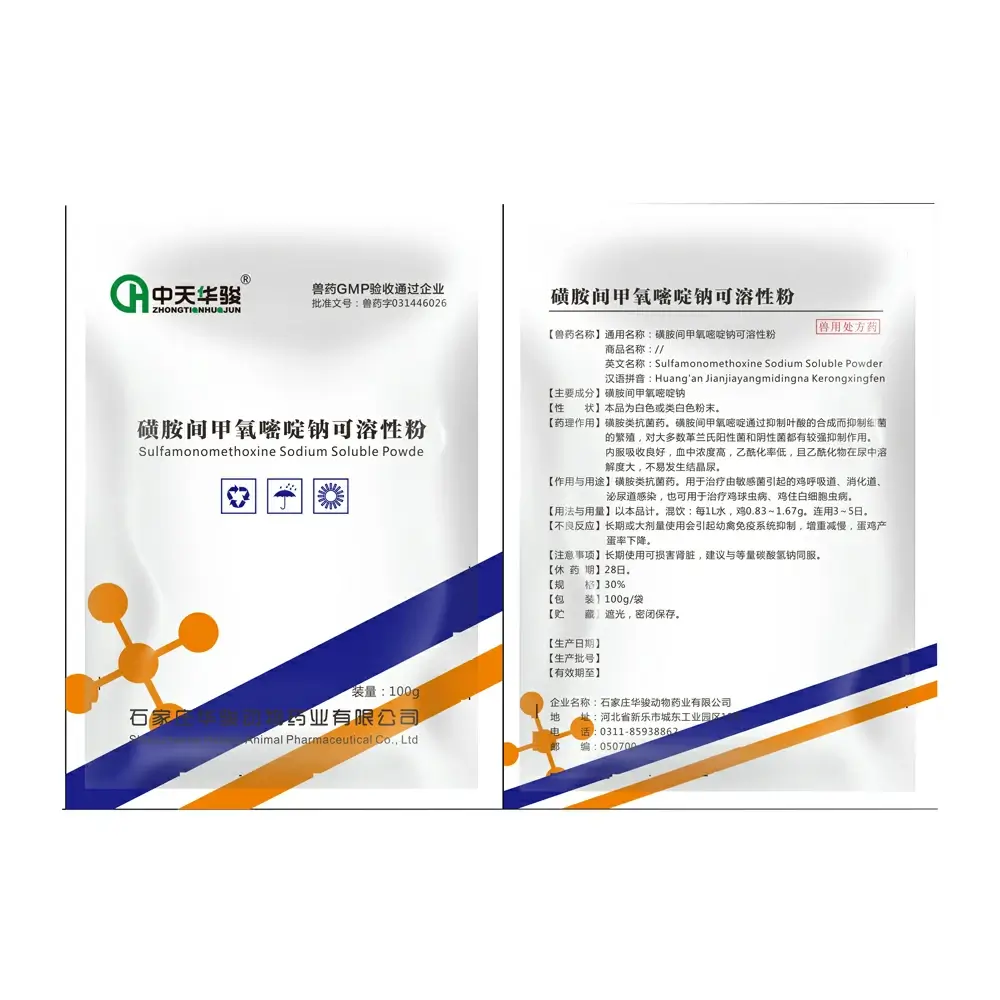
Nov . 12, 2024 08:47 Back to list
sulfamono methoxine
The Role of Sulfamonomethoxine in Veterinary Medicine
Sulfamonomethoxine (SMM) is a sulfonamide antibiotic that has been widely utilized in veterinary medicine for its effectiveness in treating various bacterial infections in livestock and companion animals. As part of the larger family of sulfonamides, SMM functions by inhibiting the bacterial synthesis of folic acid, which is essential for DNA synthesis and growth. This article explores the significance, applications, and implications of sulfamonomethoxine in veterinary practice.
Mechanism of Action
Sulfamonomethoxine works by competitively inhibiting the enzyme dihydropteroate synthase, which is involved in the bacterial synthesis of folate. By blocking this pathway, SMM hinders the growth and reproduction of bacteria. This action is primarily effective against a range of Gram-positive and Gram-negative bacteria, making SMM a versatile antibiotic for treating infections. Its bacteriostatic action distinguishes it from bactericidal antibiotics that kill bacteria outright.
Applications in Veterinary Medicine
Sulfamonomethoxine has found its place in the treatment protocols for both food-producing animals, such as cattle, sheep, and poultry, and companion animals like dogs and cats. It is particularly effective in managing respiratory infections, urinary tract infections, and gastrointestinal tract infections. In addition, SMM is frequently employed in treating infections caused by organisms such as Escherichia coli, Salmonella, and Streptococcus.
One of the advantages of using sulfamonomethoxine is its residual activity, which allows for prolonged therapeutic effects. This extended duration is particularly beneficial in livestock management, where consistent dosing is crucial for preventing disease outbreaks in herds.
Benefits and Advantages
sulfamono methoxine

The use of sulfamonomethoxine in veterinary settings offers numerous benefits. Firstly, it is a cost-effective treatment option compared to other antimicrobial agents. This aspect is particularly important for farmers and pet owners who are managing healthcare expenses.
Secondly, SMM is often less likely to elicit adverse reactions compared to some other antibiotics. This safety profile enhances its compatibility in diverse animal populations, though it is always essential to monitor for potential side effects, such as allergic reactions or gastrointestinal disturbances.
Moreover, sulfamonomethoxine can be administered via various routes, including oral and intravenous, providing flexibility in treatment protocols. This versatility makes it an ideal choice for a range of clinical scenarios, from minor infections to more serious conditions requiring hospitalization.
Concerns and Controversies
Despite its many advantages, the use of sulfamonomethoxine and other antibiotics in veterinary medicine has come under scrutiny due to concerns over antibiotic resistance. The overuse or misuse of antimicrobials in livestock can contribute to the development of resistant bacterial strains, which poses a significant public health risk. Consequently, veterinary practitioners must adhere to responsible use guidelines, ensuring that SMM is only utilized when necessary and that treatment durations are appropriate.
Additionally, regulatory bodies in various countries have implemented guidelines concerning drug residues in food products. This is particularly pertinent for food-producing animals, where the presence of sulfonamide residues in meat and milk can lead to food safety issues. As such, farmers and veterinarians must balance effective treatment with food safety considerations, ensuring compliance with withdrawal times post-treatment.
Conclusion
Sulfamonomethoxine plays a vital role in veterinary medicine, offering an effective means of managing bacterial infections in a variety of animal species. Its mechanism of action, cost-effectiveness, and flexibility in administration make it a valuable tool in the clinician's arsenal. However, veterinarians must remain mindful of the potential for antibiotic resistance and adhere to best practices to ensure the sustainability of this important medication. As veterinary medicine continues to evolve, the role of sulfamonomethoxine will likely adapt, highlighting the ongoing need for careful stewardship in the use of antibiotics in animal health.
-
Quality Bacillus Coagulans BC30 Factory - Expert Production
NewsAug.02,2025
-
China Salivation AI with GPT-4 Turbo Features
NewsAug.01,2025
-
Epic Sepsis Factories: AI-Driven Detection with GPT-4 Turbo
NewsJul.31,2025
-
Acute Salpingitis and Oophoritis AI Factory
NewsJul.31,2025
-
Premium China Bacillus Subtilis Supplier & Factory Solutions
NewsJul.30,2025
-
Premium Avermectin Supplier in China | Custom Solutions Available
NewsJul.29,2025




